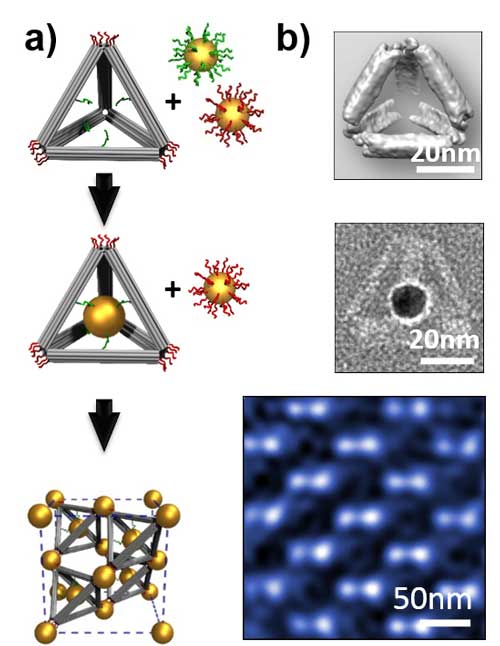
a) Illustration of the approach used to fabricate a diamond superlattice with gold nanoparticles and DNA.b)Experimental results: Top: Cryo-transmission electron microscopy density map of a DNA tetrahedron. Middle: Transmission electron microscopy image of a DNA-caged nanoparticle (scale bars, 20 nm). Bottom: High magnification scanning transmission electron microscopy image of the diamond superlattice along the [110] zone axis (scale bar, 50 nm). Image: Oleg Gang
The remarkable properties that diamonds possess result from their crystalline structure; similar structures in which nanoparticles substitute for carbon atoms could lead to materials with new and undiscovered properties.
For the first time, scientists realized ordered arrays (superlattices) of nanoparticles, which self-organize in the same way that carbon atoms do within a diamond lattice (Science, “Diamond family of nanoparticle superlattices”).
This new self-organization scheme traps nanoparticles in self-assembled DNA cages that then form large, ordered nanoparticle assemblies.
This novel method of using DNA as linkers of and cages for nanoparticles redefines the rules for connecting nanoparticles and opens exciting prospects for the bottom-up creation of complex nanomaterials with yet undiscovered properties for applications in energy conversion, energy storage, and computing applications, among others.
For the first time, scientists devised ordered arrays (superlattices) of nanoparticles, which organize in the same way that carbon atoms do within the diamond lattice.
They achieved these diamond-type superlattices by associating DNA-functionalized gold nanoparticles with “guest” nanoparticles that were encaged by tetrahedral frames made from rigid DNA bundles.
By varying the size or species of the “guests,” the team produced variants of the diamond lattice, with and without an analog in atomic lattices.
The team used the Center for Functional Nanomaterials’ Materials Synthesis & Characterization and Electron Microscopy Facilities to produce the superlattices and to characterize their structures using electron microscopy methods (transmission electron microscopy (TEM), scanning TEM, and cryo-TEM).
The team used the Center for Functional Nanomaterials’ Advanced X-ray Probes Facility at the National Synchrotron Light Source to acquire small-angle x-ray scattering data; they used the Theory and Computation Facility for modeling.
Source: Brookhaven National Laboratory




